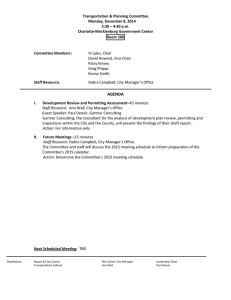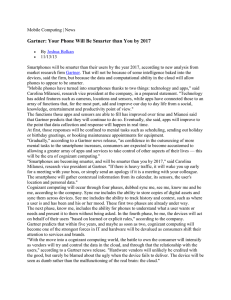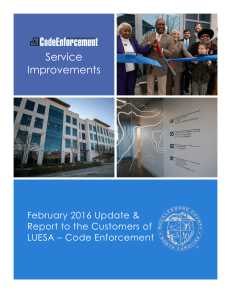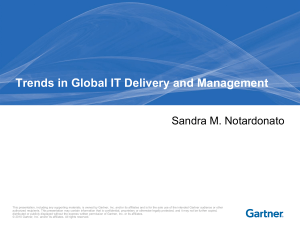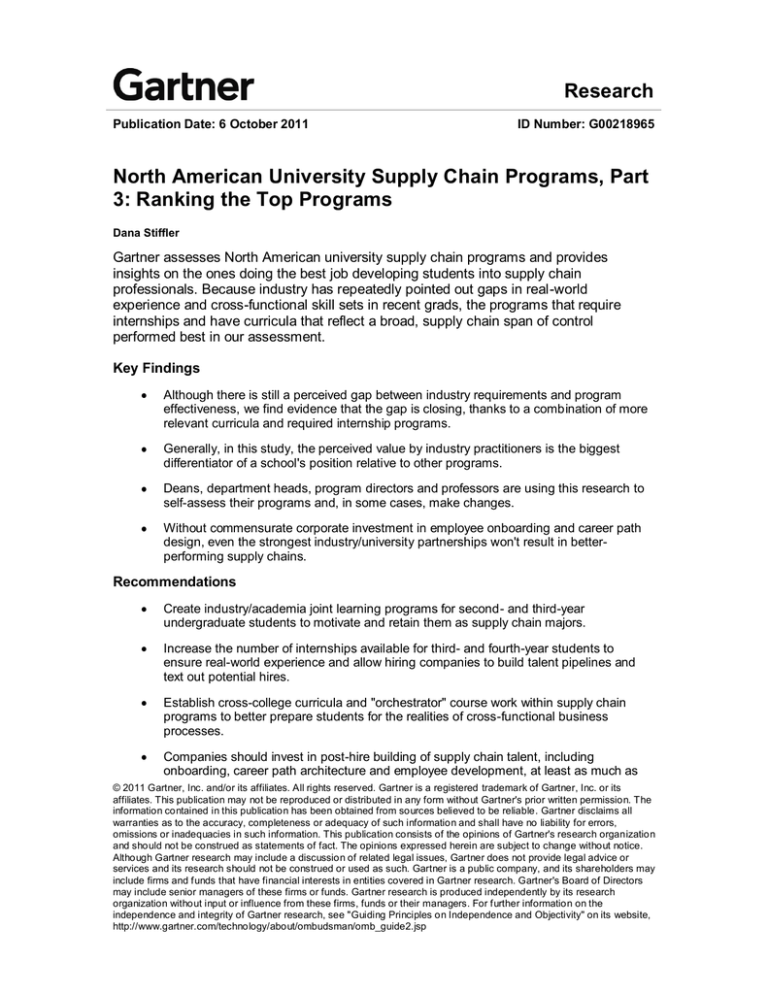
Research
Publication Date: 6 October 2011
ID Number: G00218965
North American University Supply Chain Programs, Part
3: Ranking the Top Programs
Dana Stiffler
Gartner assesses North American university supply chain programs and provides
insights on the ones doing the best job developing students into supply chain
professionals. Because industry has repeatedly pointed out gaps in real-world
experience and cross-functional skill sets in recent grads, the programs that require
internships and have curricula that reflect a broad, supply chain span of control
performed best in our assessment.
Key Findings
Although there is still a perceived gap between industry requirements and program
effectiveness, we find evidence that the gap is closing, thanks to a combination of more
relevant curricula and required internship programs.
Generally, in this study, the perceived value by industry practitioners is the biggest
differentiator of a school's position relative to other programs.
Deans, department heads, program directors and professors are using this research to
self-assess their programs and, in some cases, make changes.
Without commensurate corporate investment in employee onboarding and career path
design, even the strongest industry/university partnerships won't result in betterperforming supply chains.
Recommendations
Create industry/academia joint learning programs for second- and third-year
undergraduate students to motivate and retain them as supply chain majors.
Increase the number of internships available for third- and fourth-year students to
ensure real-world experience and allow hiring companies to build talent pipelines and
text out potential hires.
Establish cross-college curricula and "orchestrator" course work within supply chain
programs to better prepare students for the realities of cross-functional business
processes.
Companies should invest in post-hire building of supply chain talent, including
onboarding, career path architecture and employee development, at least as much as
© 2011 Gartner, Inc. and/or its affiliates. All rights reserved. Gartner is a registered trademark of Gartner, Inc. or its
affiliates. This publication may not be reproduced or distributed in any form without Gartner's prior written permission. The
information contained in this publication has been obtained from sources believed to be reliable. Gartner disclaims all
warranties as to the accuracy, completeness or adequacy of such information and shall have no liability for errors,
omissions or inadequacies in such information. This publication consists of the opinions of Gartner's research organization
and should not be construed as statements of fact. The opinions expressed herein are subject to change without notice.
Although Gartner research may include a discussion of related legal issues, Gartner does not provide legal advice or
services and its research should not be construed or used as such. Gartner is a public company, and its shareholders may
include firms and funds that have financial interests in entities covered in Gartner research. Gartner's Board of Directors
may include senior managers of these firms or funds. Gartner research is produced independently by its research
organization without input or influence from these firms, funds or their managers. For further information on the
independence and integrity of Gartner research, see "Guiding Principles on Independence and Objectivity" on its website,
http://www.gartner.com/technology/about/ombudsman/omb_guide2.jsp
they do in their university recruiting strategies. As difficult as it is to attract and hire top
talent, retaining the best and brightest is the real trick.
Publication Date: 6 October 2011/ID Number: G00218965
© 2011 Gartner, Inc. and/or its Affiliates. All Rights Reserved.
Page 2 of 13
ANALYSIS
"The only thing that interferes with my learning is my education." — Albert Einstein
In a concise string of eleven words, perhaps Einstein best sums up the industry/academia
experience gap. Industry looks for recruits who can make contributions to solving real-world
problems, but oftentimes feel that they leave university programs lacking adequate skills to make
these types of contributions. Recruits may be "book smart," yet deficient in the ways of the
working world.
The Supply Chain Council's Supply Chain Talent Academic Initiative (SCTAI) conducted a study
in 2010 to gauge the sentiment of students who were enrolled in supply chain programs. The
study found that nearly 80% had made the decision to enter the field of study after beginning their
university careers, usually on the recommendation of a friend or advisor at that level. It also found
that 70% decided to stay in the field after completing an internship and learning of career
opportunities. The lesson learned? Attracting, developing and retaining students in degree
programs are shared efforts between industry and academia.
In Part 2 of this research, we provided industry's views on the hurdles to and opportunities in
meeting the challenges in partnering with academia (see "North American University Supply
Chain Programs, Part 2: Industry Rates the Recruits"). The expanding scope of supply chain, its
increasing significance as an enabler to business strategy and its potential to drive top-line
revenue create needs for new types of talent. Although they're still expected to build working
knowledge of specific supply chain disciplines in students, the programs viewed as most valuable
by industry will produce a graduate with a broad knowledge of the cause-and-effect relationships
between disciplines on end-to-end business processes. Cross-college curricula, experiential
learning programs and use of internships earlier at sophomore and junior levels are tools that
leading programs will use to produce the well-rounded recruit.
Scope of This Report
Measuring Program Effectiveness
We used the Talent Attribute Model once again this year to assess completeness of university
curricula (see Figure 1). The model was created in 2008 and used in our first report (see "Leading
U.S. Supply Chain Programs, 2009") (Note: This document has been archived; some of its
content may not reflect current conditions). It was developed and tested by AMR Research as a
modern and comprehensive model, incorporating the expanding breadth of capabilities that can
be found in a modern supply chain. The model is composed of 11 capabilities — seven functional
and four enabling — which we refer to as "stations."
Publication Date: 6 October 2011/ID Number: G00218965
© 2011 Gartner, Inc. and/or its Affiliates. All Rights Reserved.
Page 3 of 13
Figure 1. Supply Chain Talent Attribute Model
Source: Gartner (October 2011)
With the Talent Attribute Model as the capabilities framework for the ideal supply chain, we test
university curricula for the completeness of their offerings against the 11 stations. Effectively, we
are testing for curriculum alignment with the functional integration of a modern supply chain. It's
especially relevant this year, since our industry surveys continue to show the expansion of the
number of functions within the supply chain organization, and a desire by industry for recruits who
can grasp big-picture, integrated supply chain concepts.
Data for this research is gathered through surveys and interviews of industry and academia. The
surveys are designed to quantify industry requirements, and gather information on university
program composition, including numbers of students and professors, as well as the scope of the
curriculum. Three categories are evaluated, using the research methodology detailed in Figure 2,
to determine comparative position in the study.
Publication Date: 6 October 2011/ID Number: G00218965
© 2011 Gartner, Inc. and/or its Affiliates. All Rights Reserved.
Page 4 of 13
Figure 2. Three Evaluation Criteria for University Programs
Source: Gartner (October 2011)
The Research Methodology
Our methodology for this year's program assessments extends on what was used in our
inaugural report in 2009, adding other dimensions for evaluation. In 2010, Gartner sent an RFI to
our contacts at supply chain programs in the U.S. and internationally. We followed up the RFIs
with interviews with many of the schools, and conducted research on university websites and
Publication Date: 6 October 2011/ID Number: G00218965
© 2011 Gartner, Inc. and/or its Affiliates. All Rights Reserved.
Page 5 of 13
course catalogs to ensure that the RFIs were complete and accurate. Responses and
clarifications were collected through 2010.
Here are some details on the university participants:
Fifty-three universities responded to the RFI.
Thirty-six schools submitted information on undergraduate supply chain programs.
Thirty-four schools submitted information on graduate-level supply chain programs.
Often, but not always, supply chain graduate programs are hosted within business
schools.
Nineteen schools from 2009 returned to participate in this year's research, with 17 new
participants.
The foundation for this ranking of supply chain programs was based on program-supplied RFI
information, but additional input into the "industry value" component of the ranking comes from a
survey of current supply chain and recruiting professionals. Survey respondents said that the
quality and effectiveness of the recruiting pool are improved when students have real-world
experience. Gartner, in turn, has responded by assessing each program's use of internships. We
feel this is an indicator of a program's focus on providing relevant learning experiences for the
real world and the effectiveness of its industry partnerships (that is, the source of internships).
The RFIs were sent to a Gartner internal database of supply chain industry contacts, with links to
the survey posted by the universities. The evaluation criteria for the university programs appear in
Figure 2. The final placement of university programs in our relative comparison is based on a
composite score of three categories: industry value, program size and program scope.
For ranking purposes only, the internal database responses were used for the "program
mentions" and "best program" scoring. Although the survey responses received via university
distribution of the survey link were useful for our overall market analysis, it would have biased the
results to use that data in our ranking.
The supply chain course score used for the undergraduate and graduate-level "scope" ranking is
based on the courses listed in RFI responses and on the evaluation of course catalogs against
the supply chain Talent Attribute Model. A higher score indicates more complete coverage of the
11 supply chain stations.
A Snapshot of Each Evaluation Criterion
Industry Value
Once again this year, indicators of perceived industry value are the schools on which recruiters
focus, the programs viewed as having the best quality of recruits and, finally, the average starting
salaries for program graduates.
This year, we also added internships as an explicit indicator of industry value. Our rationale is that
industry sets up internships in partnership with institutions where the overall program and its
students align well with a company's needs. Beyond that, we view programs that require
internships to be indicative of programs that are preparing students to solve real-world problems
through real-world experience, which are two key and recurring gaps in our industry survey of
university program strengths.
Publication Date: 6 October 2011/ID Number: G00218965
© 2011 Gartner, Inc. and/or its Affiliates. All Rights Reserved.
Page 6 of 13
This combination of mentions, best mentions, average salary and required internship (or other
real-world experience) makes up a composite view of perceived industry value.
Program Scope
We framed the scope of a supply chain with the Talent Attribute Model. As we evaluated
programs, we looked for curricula that aligned with the 11 stations of the model. Client interviews
through the past year indicate that industry places a premium on supply chain recruits who have
a broad understanding of supply chain concepts and the cause-and-effect relationships between
the disciplines.
Program Size
The number of supply chain students and professors in the program provides quantification of a
given university's ability to sustain a pipeline of supply chain management (SCM) recruits for
industry. Even though the need for quality and quantity of recruits for supply chain continues to be
a theme as we talk to industry clients, program size received relatively less weight than in
previous outings. Also, to fairly contrast programs, we considered undergraduate and graduate
student populations separately. We also considered only full-time professors engaged in
classroom delivery of supply chain courses or research related to the supply chain program.
Highlights From This Year's Report
Pennsylvania State University again tops our rankings for both undergraduate and
graduate programs.
There were 17 new programs evaluated in this year's study, and 14 of them made one
or both lists.
Eleven undergraduate programs were first-year participants in this ranking. Eight
graduate programs were newcomers.
Mean industry value score was 5.7 out of 10. The median was 5.5.
The most highly ranked new entrant in the undergraduate field was the University of
Texas at Austin at No. 6. Stanford was the most highly ranked new graduate entrant
(No. 11).
There were significant advances made by select programs — notably, Rutgers in both
the graduate and undergraduate categories, and Georgia Tech in the undergraduate
rankings.
How the Universities Stacked Up
Undergraduate Programs
The top U.S. undergraduate supply chain programs share balanced excellence across curricula,
graduate performance in the real world and overall reputation. Penn State again claims the No. 1
position, but upstarts this year included Rutgers, University of Texas at Austin and Marquette
(see Figure 3).
Publication Date: 6 October 2011/ID Number: G00218965
© 2011 Gartner, Inc. and/or its Affiliates. All Rights Reserved.
Page 7 of 13
Figure 3. Undergraduate Supply Chain Program Ranking
Source: Gartner (October 2011)
Though smaller by comparison to the other programs in the top five and most other
undergraduate programs we evaluated, Wisconsin scores highest in our industry value category,
edging its way to the top with a solid score in our newest category, required internships and co-op
programs (see Figure 4). Penn State, Georgia Tech, Michigan State and Syracuse are all closely
grouped at the top of the industry value category. Georgia Tech scores highest among all
universities for the sheer number of best mentions by industry, which reflects its strong brand with
the supply chain community at large.
Publication Date: 6 October 2011/ID Number: G00218965
© 2011 Gartner, Inc. and/or its Affiliates. All Rights Reserved.
Page 8 of 13
Figure 4. Top Undergraduate Programs in Industry Value, Program Scope and Program
Size
Source: Gartner (October 2011)
Programs that scored highest for internships were Rutgers, University of Texas at Austin, Rider,
Syracuse, North Texas, South Carolina and Wisconsin. Graduates of programs that scored
highest in internships tend to command higher starting salaries, but we did identify the University
of Texas as a "best buy" program (from a corporate recruitment standpoint), where real-world
exposure is extensive, but starting salaries are relatively modest.
For program scope, where a diverse, balanced program based on the Talent Attribute Model
received the highest marks, the top performer was Penn State, followed closely by Arizona State,
Kansas, Marquette, Rutgers, Stanford and University of Texas.
If there is a message in the performance of these programs, it's that balance is key to building
positive perception. For the top five programs, all perform at or better than the midpoint in all
categories, and lead in some.
Publication Date: 6 October 2011/ID Number: G00218965
© 2011 Gartner, Inc. and/or its Affiliates. All Rights Reserved.
Page 9 of 13
Graduate Programs
Many familiar names from the undergraduate list pop up again in our graduate ranking, with Penn
State again grabbing the No. 1 spot. Programs that rate on the graduate list, but not undergrad,
are University of Michigan, MIT, University of Texas at Dallas, San Diego State, University of
Florida, North Carolina State and Oklahoma (see Figure 5).
Figure 5. Graduate Supply Chain Program Ranking
Source: Gartner (October 2011)
For industry value — the most influential yardstick in the rankings — there appears to be a "Big
Four" among graduate programs. Penn State, Michigan, Georgia Tech and Michigan State are
close together, and far ahead of the pack, in all industry value subcategories: recruit mentions,
industry best-program mentions, required internship/co-op and average starting salary. Top
program scope scores, with maximum coverage of the 11 stages of the Talent Attribute Model,
were achieved by Arizona State, Lehigh, Penn State and Rutgers.
Publication Date: 6 October 2011/ID Number: G00218965
© 2011 Gartner, Inc. and/or its Affiliates. All Rights Reserved.
Page 10 of 13
Penn State ends up dominating the graduate list because of its high industry value score, broad
and deep program scope, and size (see Figure 6).
Figure 6. Top Graduate Programs by Industry Value, Program Scope and Program Size
Source: Gartner (October 2011)
M.S. Versus M.B.A.: The Difference
One major difference in program scores is that M.B.A. programs tend to require internships or
have them integrated as a mainstream opportunity compared to M.S. and Ph.D. programs. Since
we heavily weighted required internships in our assessment this year, with all other things being
equal, the M.B.A. program, with required internships, would have the edge over an M.S. program,
with optional internships.
Publication Date: 6 October 2011/ID Number: G00218965
© 2011 Gartner, Inc. and/or its Affiliates. All Rights Reserved.
Page 11 of 13
Conclusions
In the first incarnation of this research in 2009, we asked, "What does it mean to run a great
university supply chain program in the United States?" and proceeded to lay out definitions for
industry value and program scope. Our finding at the time was that scope needed to expand, as
did opportunities for working on real-world problems. In this second edition, we can happily say
that programs have made progress in two key areas:
Adding course work that reflects the expanding span of control of supply chain
Strengthening industry partnerships that promote quality internships and opportunities
for students to participate in hands-on projects
Capability gaps that have yet to be addressed by a suitable combination of curricula and
experiential exposure include finance and risk management, sustainability, and global operating
environments. Also, while more programs are expanding scope to go deeper into top-lineoriented areas of the supply chain, such as product innovation and aftermarket services, there is
still a concern that new hires are not coming on board with the right orientation toward
orchestration — that is, the enabling skill sets in the Talent Attribute Model: strategy and change
management, governance and relationship management, and performance management and
analytics. As industry boards and recruiters continue to press on these needs, we would expect to
see greater cross-curriculum cooperation, as well as more industry-sponsored competition and
project opportunities that emphasize these skills.
Finally, we would press undergraduate programs to supply these opportunities sooner rather than
later. Data gathered in 2010 validates that nearly four in five students decided on a supply chain
career while at a university, and 70% decided to stay with the major because of internships and
career opportunities. For this reason, more targeted projects and internship vehicles for secondand third-year students are a must.
RECOMMENDED READING
Some documents may not be available as part of your current Gartner subscription.
"North American Supply Chain University Programs, Part 1: Why Co-Investment in Supply Chain
Talent Is a Must"
"North American Supply Chain University Programs, Part 2: Industry Rates the Recruits"
"Help Wanted: Two Leaders to Orchestrate Value in the Modern Supply Chain"
"Lessons Learned From Chemical Supply Chain Leaders: Refill Your Talent Pipeline"
Publication Date: 6 October 2011/ID Number: G00218965
© 2011 Gartner, Inc. and/or its Affiliates. All Rights Reserved.
Page 12 of 13
REGIONAL HEADQUARTERS
Corporate Headquarters
56 Top Gallant Road
Stamford, CT 06902-7700
U.S.A.
+1 203 964 0096
European Headquarters
Tamesis
The Glanty
Egham
Surrey, TW20 9AW
UNITED KINGDOM
+44 1784 431611
Asia/Pacific Headquarters
Gartner Australasia Pty. Ltd.
Level 9, 141 Walker Street
North Sydney
New South Wales 2060
AUSTRALIA
+61 2 9459 4600
Japan Headquarters
Gartner Japan Ltd.
Aobadai Hills, 6F
7-7, Aobadai, 4-chome
Meguro-ku, Tokyo 153-0042
JAPAN
+81 3 3481 3670
Latin America Headquarters
Gartner do Brazil
Av. das Nações Unidas, 12551
9° andar—World Trade Center
04578-903—São Paulo SP
BRAZIL
+55 11 3443 1509
Publication Date: 6 October 2011/ID Number: G00218965
© 2011 Gartner, Inc. and/or its Affiliates. All Rights Reserved.
Page 13 of 13

